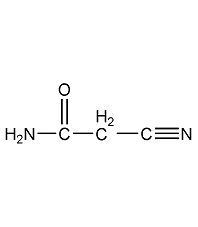
Structural formula
| Business number | 02VZ |
|---|---|
| Molecular formula | C3H4N2O |
| Molecular weight | 84.08 |
| label |
2-cyanoacetamide, Cyanoacetamide, Cyanoacetamide, 2-cyanoacetamide, 2-Cyanoacetamide |
Numbering system
CAS number:107-91-5
MDL number:MFCD00008024
EINECS number:203-531-8
RTECS number:AB5950000
BRN number:878221
PubChem number:24846668
Physical property data
1. Properties: White or yellow needle-like crystals or powder.
2. Density (g/mL, 25℃): Undetermined
3. Relative vapor density (g/mL, air=1): Undetermined
4. Melting point (ºC): 121-122
5. Boiling point (ºC, normal pressure): Undetermined
6. Boiling point (ºC, kPa): Undetermined
7. Refractive index (D20): Undetermined
8. Flash point (ºC): 215
9. Specific rotation (ºC): Undetermined
10. Autoignition point or ignition temperature (ºC): Undetermined
11. Vapor pressure (mmHg, 20ºC): Undetermined
12. Saturated vapor pressure (kPa, 20ºC): Undetermined
13. Heat of combustion (KJ/mol): Undetermined
14. Critical temperature (ºC): Undetermined
15. Critical pressure (KPa): Undetermined
16. Log value of oil-water (octanol/water) partition coefficient: Undetermined
17. Explosion upper limit (%, V/V): Undetermined
18. Explosion lower limit (%, V/V): Undetermined
19. Solubility: Slightly soluble in water, soluble in ethanol.
Toxicological data
1. Acute toxicity: oral LD50 in mice: 1680mg/kg; intraperitoneal LD50 in mice: 200mg/kg; subcutaneous LD50 in guinea pigs: 1155mg/kg;
Ecological data
This substance is slightly hazardous to water.
Molecular structure data
1. Molar refractive index: 19.42
2. Molar volume (cm3/mol): 72.2
3. Isotonic specific volume (90.2K ): 193.9
4. Surface tension (dyne/cm): 51.9
5. Polarizability (10-24cm3): 7.70
Compute chemical data
1. Reference value for hydrophobic parameter calculation (XlogP): -1
2. Number of hydrogen bond donors: 1
3. Number of hydrogen bond acceptors: 2
p>
4. Number of rotatable chemical bonds: 1
5. Number of tautomers: 3
6. Topological molecule polar surface area 66.9
7. Number of heavy atoms: 6
8. Surface charge: 0
9. Complexity: 98.6
10. Number of isotope atoms: 0
11. Determine the number of atomic stereocenters: 0
12. Uncertain number of atomic stereocenters: 0
13. Determine the number of chemical bond stereocenters: 0
14. Number of uncertain chemical bond stereocenters: 0
15. Number of covalent bond units: 1
Properties and stability
1. Avoid contact with strong oxidants, strong reducing agents, strong acids, and reducing agents.
2.This product has low toxicity. The LD50 of oral administration to mice is 3200mg/kg.
Storage method
1. Store in a cool, ventilated warehouse. Keep away from fire and heat sources. They should be stored separately from oxidants, reducing agents, acids, and reducing agents, and avoid mixed storage. Equipped with the appropriate variety and quantity of fire equipment. Suitable materials should be available in the storage area to contain spills.
2. This reagent is packed in glass bottles, 25g per bottle, and should be sealed and stored.
Synthesis method
It can be prepared by the reaction between ethyl cyanoacetate and ammonia. Cool the ethyl cyanoacetate to below 200°C, add concentrated ammonia water to react, and the mixture turns from turbid to clear. After cooling in cold water for 20 minutes, a precipitate precipitates. After filtering and drying, the crude product is obtained, and then the crude cyanoacetamide is added. In boiling ethanol, after it is dissolved, add a small amount of activated carbon for decolorization and refinement, filter, and the filtrate is cooled to precipitate. After spin-drying, it is dried at 80-100°C to obtain fine cyanoacetamide.

Purpose
It is used for the synthesis of malononitrile and electroplating solutions. It is also used for the synthesis of the drugs triamterene and triamterene.

 微信扫一扫打赏
微信扫一扫打赏

